CHART UltraDoser 150S User manual

Part Number 20552241 Rev. D
© 2016 Chart Inc.
Designed and Built by:
Chart Inc.
46441 Landing Parkway
Fremont, CA 94538 USA
(800) 371-3303
Product Manual
UltraDoser®150S
Liquid Nitrogen Dosing System


iii
Product Manual - UltraDoser®150S LN2Dosing System
Contents
Revision Log . . . . . . . . . . . . . . . . . . . . . . . . . . . . . . . . . . . . . . . . . . . . . . iv
Preface . . . . . . . . . . . . . . . . . . . . . . . . . . . . . . . . . . . . . . . . . . . . . . . . . . . . .1
General . . . . . . . . . . . . . . . . . . . . . . . . . . . . . . . . . . . . . . . . . . . . . . . . . .1
Features . . . . . . . . . . . . . . . . . . . . . . . . . . . . . . . . . . . . . . . . . . . . . . . . . .1
Key Benets . . . . . . . . . . . . . . . . . . . . . . . . . . . . . . . . . . . . . . . . . . . . . . . .1
Product Manual . . . . . . . . . . . . . . . . . . . . . . . . . . . . . . . . . . . . . . . . . . . . . .1
Terms . . . . . . . . . . . . . . . . . . . . . . . . . . . . . . . . . . . . . . . . . . . . . . . . . . .2
Acronyms / Abbreviations. . . . . . . . . . . . . . . . . . . . . . . . . . . . . . . . . . . . . . . . .2
Safety . . . . . . . . . . . . . . . . . . . . . . . . . . . . . . . . . . . . . . . . . . . . . . . . . . . . .3
General . . . . . . . . . . . . . . . . . . . . . . . . . . . . . . . . . . . . . . . . . . . . . . . . . .3
Safety Bulletin. . . . . . . . . . . . . . . . . . . . . . . . . . . . . . . . . . . . . . . . . . . . . . .4
Oxygen Decient Atmospheres . . . . . . . . . . . . . . . . . . . . . . . . . . . . . . . . . . . . . .4
Nitrogen . . . . . . . . . . . . . . . . . . . . . . . . . . . . . . . . . . . . . . . . . . . . . . . . . .4
Receiving and Installation . . . . . . . . . . . . . . . . . . . . . . . . . . . . . . . . . . . . . . . . . .5
Receiving . . . . . . . . . . . . . . . . . . . . . . . . . . . . . . . . . . . . . . . . . . . . . . . . .5
Unpacking . . . . . . . . . . . . . . . . . . . . . . . . . . . . . . . . . . . . . . . . . . . . . . . . .5
Installation. . . . . . . . . . . . . . . . . . . . . . . . . . . . . . . . . . . . . . . . . . . . . . . . .5
Application Evaluation . . . . . . . . . . . . . . . . . . . . . . . . . . . . . . . . . . . . . . . .5
Support Stand Location. . . . . . . . . . . . . . . . . . . . . . . . . . . . . . . . . . . . . . . .6
Mounting the UltraDoser Unit . . . . . . . . . . . . . . . . . . . . . . . . . . . . . . . . . . . .6
Installing the 150S Controller . . . . . . . . . . . . . . . . . . . . . . . . . . . . . . . . . . . .7
Installing the Nozzle . . . . . . . . . . . . . . . . . . . . . . . . . . . . . . . . . . . . . . . . .8
Positioning the Dosing Head . . . . . . . . . . . . . . . . . . . . . . . . . . . . . . . . . . . . .8
Installing the Bottle Detect Sensor . . . . . . . . . . . . . . . . . . . . . . . . . . . . . . . . . .9
Operation . . . . . . . . . . . . . . . . . . . . . . . . . . . . . . . . . . . . . . . . . . . . . . . . . . 11
Principles of Liquid Nitrogen Dosing . . . . . . . . . . . . . . . . . . . . . . . . . . . . . . . . . .11
Pure Liquid at the Dosing Head . . . . . . . . . . . . . . . . . . . . . . . . . . . . . . . . . . 11
Constant Pressure. . . . . . . . . . . . . . . . . . . . . . . . . . . . . . . . . . . . . . . . . .11
Dose Duration . . . . . . . . . . . . . . . . . . . . . . . . . . . . . . . . . . . . . . . . . . . 11
Controller Adjustments . . . . . . . . . . . . . . . . . . . . . . . . . . . . . . . . . . . . . . . . . 11
Duration (of Dose) . . . . . . . . . . . . . . . . . . . . . . . . . . . . . . . . . . . . . . . . . 11
Dose Delay . . . . . . . . . . . . . . . . . . . . . . . . . . . . . . . . . . . . . . . . . . . . . 12
150S Controller Set-up Verication . . . . . . . . . . . . . . . . . . . . . . . . . . . . . . . . 13
Other Screens . . . . . . . . . . . . . . . . . . . . . . . . . . . . . . . . . . . . . . . . . . . .13
Daily Operating Procedures . . . . . . . . . . . . . . . . . . . . . . . . . . . . . . . . . . . . . . .13
Purging with Gaseous Nitrogen . . . . . . . . . . . . . . . . . . . . . . . . . . . . . . . . . . 13
System Start Up. . . . . . . . . . . . . . . . . . . . . . . . . . . . . . . . . . . . . . . . . . .14
System Shut Down . . . . . . . . . . . . . . . . . . . . . . . . . . . . . . . . . . . . . . . . . 14
Dura-Cyl® Liquid Cylinder (22 psi) Change Out Procedure . . . . . . . . . . . . . . . . . . . .14
Service and Maintenance . . . . . . . . . . . . . . . . . . . . . . . . . . . . . . . . . . . . . . . . . .15
Nozzle Change Out Procedure . . . . . . . . . . . . . . . . . . . . . . . . . . . . . . . . . . . . . 15
Nozzle Cleaning Procedure . . . . . . . . . . . . . . . . . . . . . . . . . . . . . . . . . . . . . . . 15
Replacement Parts . . . . . . . . . . . . . . . . . . . . . . . . . . . . . . . . . . . . . . . . . . . .16
Troubleshooting . . . . . . . . . . . . . . . . . . . . . . . . . . . . . . . . . . . . . . . . . . . . . 16
Specications . . . . . . . . . . . . . . . . . . . . . . . . . . . . . . . . . . . . . . . . . . . . . . . . 19
UltraDoser Technical Specications . . . . . . . . . . . . . . . . . . . . . . . . . . . . . . . . . . 19
Controller Technical Specications . . . . . . . . . . . . . . . . . . . . . . . . . . . . . . . . . . . 19
UltraDoser 150S Components. . . . . . . . . . . . . . . . . . . . . . . . . . . . . . . . . . . . . .20
Warranty . . . . . . . . . . . . . . . . . . . . . . . . . . . . . . . . . . . . . . . . . . . . . . . . . . 23

iv
Table of Contents Product Manual - UltraDoser®150S LN2Dosing System
Revision Log
Revision Level Date Description
B 08/24/2015 Reformat with new layout
C 06/09/2016
Update pages 12 and 19 for minimum dose amount of 20mS instead of 10mS.
Update CryotechFlex hose to CFlex throughout. Update trademarks, update
warranty section.
D 06/20/2016 Update warranty section to read 2 years

1
Product Manual - UltraDoser®150S LN2Dosing System
General
The UltraDoser® 150S LN2 Dosing System is a multi-
purpose liquid nitrogen dosing system utilizing advanced
cryogenic technology and PLC programming. LN2is
supplied to the UltraDoser unit by a vacuum insulated hose
and ows into the dosing head. A sensor detects the speed
of the line (encoder compatible); a second sensor detects the
presence of a container. When a container is detected, the
dosing head opens and dispenses an exact amount of pure
LN2. A PLC (Programmable Logic Controller) is the brains
behind integrating the sensors, controls and human interface.
Chart engineers designed an ultra-efcient system for low to
medium production line speeds to dispense a precise dose of
LN2 into every container every time. The LN2 gasies and is
either trapped in the container to add rigidity or escapes with
oxygen to inert the headspace.
Features
• Compact Size - enables installation in limited spaces
• Precise Dosing - delivers consistent, accurate dosing
• Discrete Dosing - up to 2000* containers per minute
• Discrete or Continuous Dosing - change over dened by
user
• SoftDose™ Compatible - Chart’s proven technology for
hot ll, powder, and granular applications
• RemoteDose™ Capable - monitor and troubleshoot
the system remotely thereby minimizing or eliminating
system downtime
• MicroDose™ Capable - designed specically for tight
pressure specications
• IntelliDose™ Capable - automatic dose adjustments at
any line speed between low/high points as dened by user
*Results obtained under specic conditions
Key Benets
• Lightweight PET - reduce the weight of PET for cost and
environmental savings
• Glass to PET Transition - eliminate glass safety hazards
and weight of containers
• Bottle Rigidity - maintain bottle shape even with lighter
weight containers
• Eliminate Paneling - increase the internal pressure to
offset paneling issues
• Oxygen Reduction - create an inert environment to
preserve product freshness
• Extend Shelf Life - minimize oxygen levels
• Ease of Labeling - consistent bottle rigidity creates an
efcient labeling process
• Reduce Nitrogen Consumption - Measurable and
repeatable liquid doses
• Maximize Warehouse Storage Space - increasing product
stackability utilizes less square footage
• Stabilize Organic Products - extend shelf life without
preservatives
Product Manual
This manual is designed to be used in conjunction with the
UltraDoser 150S Liquid Nitrogen Dosing System provided
by Chart. Chart makes no warranties, express or implied,
regarding the content in this manual. Chart assumes no
responsibility for any outcomes as a result of using this
manual. If after reading this manual you are not condent in
carrying out any task, please contact Chart’s service team at
1-408-371-4932.
Additional copies of this manual are available by contacting
Chart at 1-800-371-3303.
The safety requirements for operating the UltraDoser 150S
and handling or transporting extremely cold liquid products
are shown in the Safety section. Use this safety section as a
“Safety Checklist” each time the equipment is being used.
In the Installation section there are illustrations for proper
connections.
The Operations section contains set-up and operation
information along with system features and service and
maintenance.
The remaining sections provide information on Service,
Troubleshooting, Specications and the Warranty provided
by Chart.
Preface

2
Preface Product Manual - UltraDoser®150S LN2Dosing System
Terms
Throughout this manual safety precautions will be designated
as follows:
Warning! Description of a condition that
can result in personal injury or
death.
Caution! Description of a condition that
can result in equipment or
component damage.
Note: A statement that contains information
that is important enough to emphasize or
repeat.
Acronyms / Abbreviations
The following acronyms / abbreviations are used throughout
this manual:
BAR Pressure (Metric)
GN2Gaseous Nitrogen
ID Inner Diameter
Kg Kilogram
LN2 Liquid Nitrogen
MPT Male Pipe Thread
mS Milliseconds
PLC Programmable Logic Controller
PN Part Number
PSI Pounds per Square Inch
SRV Safety Relief Valve

3
Product Manual - UltraDoser®150S LN2Dosing System
General
Thank you for your purchase of Chart Inc.’s (Chart)
UltraDoser 150S Liquid Nitrogen Dosing System. Chart has
designed and fabricated your system with attention to detail
and utilizing the leading cryogenic technologies to ensure a
highly efcient and reliable system.
DO NOT use this product in a manner not consistent with
the instruction outlined in this manual.
NEVER alter the design, or perform service that is not
consistent with the instructions outlined in this manual
without prior written approval from Chart.
Strict compliance with proper safety and handling practices
is necessary when using a cryogenic system. We recommend
that all our customers re-emphasize safety and safe handling
practices to all their employees and customers. While every
possible safety feature has been designed into the system and
safe operations are anticipated, it is essential that the user
of the cryogenic system carefully read to fully understand
all WARNINGS and CAUTION notes listed in this safety
summary and enumerated below. Also read the information
provided in the Safety Bulletin for Inert Gases following this
Safety Summary. Periodic review of the Safety Summary is
recommended.
Warning! Your UltraDoser 150S system
may be fed by a vacuum
insulated pipe system designed
to contain pressurized, ultra-
cold cryogenic liquids. These
systems should only be worked
on by trained personnel to
avoid serious injuries such
as freezing, oxygen decient
atmosphere and extremely high
pressures.
External valves and ttings can become extremely cold
and may cause painful burns to personnel unless properly
protected. Personnel must wear protective gloves and eye
protection whenever removing parts or loosening ttings.
Failure to do so may result in personal injury due to the
extreme cold and pressure in the system.
Warning! Accidental contact of liquid
gases with skin or eyes may
cause a freezing injury similar to
a burn.
Handle liquid so that it will not splash or spill. Protect your
eyes and cover skin where the possibility of contact with
liquid, cold pipes and equipment, or cold gas exists. Safety
goggles or a face shield should be worn if liquid ejection
or splashing may occur or cold gas may exit forcefully
from equipment. Clean, insulated gloves that can be easily
removed and long sleeves are recommended for arm and
hand protection. Cuff less trousers should be worn over the
shoes to shed spilled liquid.
Warning! If you are at all unsure of how
to safely work on this system,
STOP and contact Chart
immediately at 1-408-371-4932.
Warning! Any conguration which allows
a trapped volume of cryogenic
liquid or cold gas must be
protected by a pressure relief
valve. As the cold liquid/
gas gains heat, the contents
will expand and increase
in pressure. A section not
protected by an over-pressure
relief valve will experience
extremely high pressures and
signicant safety concerns.
Warning! Over pressurization of bottles
(or containers) can occur while
using Chart’s UltraDoser 150S
system potentially bursting
the bottles (or containers).
Proper calibration of the
UltraDoser 150S system ensures
optimum nitrogen doses to
avoid over pressurization. Be
sure to remove any bottles (or
containers) that receive more
than its proper LN2doses before
sealing.
Caution! As with any cryogenic system,
it should be observed that any
non-insulated piping can get
extremely cold and should
not be touched by exposed
skin. If the system requires
maintenance, it should be
shutdown and allowed to warm
up.
Safety

4
Safety Product Manual - UltraDoser®150S LN2Dosing System
Caution! Before removing parts or
loosening ttings, empty the
UltraDoser 150S system of liquid
and release any vapor pressure
in a safe manner.
Safety Bulletin
Portions of the following information is extracted from
Safety Bulletin SB-2 from the Compressed Gas Association,
Inc. at www.cganet.com. Additional information on oxygen,
nitrogen, and cryogenics is available in CGA Pamphlet
P-9. Write to the Compressed Gas Association, Inc., 1235
Jefferson Davis Highway, Arlington, VA 22202..
Oxygen Decient Atmospheres
Warning! Nitrogen vapors in air may dilute
the concentration of oxygen
necessary to support or sustain
life.
The normal oxygen content of air is approximately 21%.
Depletion of oxygen content in air, either by combustion
or by displacement with inert gas, is a potential hazard and
users should exercise suitable precautions.
One aspect of this possible hazard is the response of humans
when exposed to an atmosphere containing only 8 to 12%
oxygen. In this environment, unconsciousness can be
immediate with virtually no warning.
When the oxygen content of air is reduced to approximately
15 to 16%, the ame of ordinary combustible materials,
including those commonly used as fuel for heat or light,
may be extinguished. Somewhat below this concentration,
an individual breathing the air is mentally incapable of
diagnosing the situation because the onset of symptoms
such as sleepiness, fatigue, lassitude, loss of coordination,
errors in judgment and confusion can be masked by a state of
“euphoria,” leaving the victim with a false sense of security
and well being.
Human exposure to atmosphere containing 12% or less
oxygen leads to rapid unconsciousness. Unconsciousness can
occur so rapidly that the user is rendered essentially helpless.
This can occur if the condition is reached by an immediate
change of environment, or through the gradual depletion of
oxygen.
Most individuals working in or around oxygen decient
atmospheres rely on the “buddy system” for protection -
obviously the “buddy” is equally susceptible to asphyxiation
if he or she enters the area to assist the unconscious partner
unless equipped with a portable air supply. Best protection
is obtainable by equipping all individuals with a portable
supply of respirable air. Life lines are acceptable only if the
area is essentially free of obstructions and individuals can
assist one another without constraint.
If an oxygen decient atmosphere is suspected or known to
exist:
1. Use the “buddy system.” Use more than one “buddy” if
necessary to move a fellow worker in an emergency.
2. Both the worker and “buddy” should be equipped with
self-contained or airline breathing equipment.
Nitrogen
Nitrogen (an inert gas) is a simple asphyxiate. It will not
support or sustain life and can produce immediate hazardous
conditions through the displacement of oxygen. Under high
pressure this gas may produce unconsciousness even though
an adequate oxygen supply sufcient for life is present.
Nitrogen vapors in air dilute the concentration of oxygen
necessary to support or sustain life. Inhalation of high
concentrations of this gas can cause anoxia, resulting in
dizziness, nausea, vomiting, or unconsciousness and possibly
death. Individuals should be prohibited from entering areas
where the oxygen content is below 19% unless equipped
with a self-contained breathing apparatus. Unconsciousness
and death may occur with virtually no warning if the oxygen
concentration is below approximately 8%. Contact with cold
nitrogen gas or liquid can cause cryogenic (extreme low
temperature) burns and freeze body tissue.
Persons suffering from lack of oxygen should be
immediately moved to areas with normal atmospheres.
SELF-CONTAINED BREATHING APPARATUS MAY BE
REQUIRED TO PREVENT ASPHYXIATION OF RESCUE
WORKERS. Assisted respiration and supplemental oxygen
should be given if the victim is not breathing. If cryogenic
liquid or cold boil-off gas contacts worker’s skin or eyes,
the affected tissue should be ooded or soaked with tepid
water (105-115ºF or 41-46ºC). DO NOT USE HOT WATER.
Cryogenic burns that result in blistering or deeper tissue
freezing should be examined promptly by a physician.

5
Product Manual - UltraDoser®150S LN2Dosing System
Receiving
The UltraDoser 150S system is designed for steady speed
lling lines up to 150 bottles (or containers) per minute. It
does not compensate for changes in line speed. Any changes
to the line speed may require changes to the dose settings.
Unpacking
The UltraDoser 150S system will arrive in a specially
designed shipping crate. If the unit is intended to be moved
from one location to another, storing the crate for future use
is ideal.
Upon arrival of the UltraDoser 150S system, it is advised to
immediately inspect for any signs of damage. If any damage
occurred in shipping, claims must be led with the shipping
carrier immediately prior to unpacking.
All contents should be carefully inspected while unpacking
the UltraDoser 150S system. Things to check for upon
arrival include:
• Dents in the UltraDoser unit
• Male and female bayonets should be protected
• Proper number of bayonet clamps/anges and o-rings
(one set for every female bayonet)
• Any other components that were dened to ship loose
If there are any pieces listed on the packing slip and/or
materials list not in the shipping crate, please contact Chart
immediately at 1-800-371-3303.
Caution! When removing the UltraDoser
unit from the crate, gently set
it on the ground. DO NOT drop
the UltraDoser unit! When
transporting the unit through the
facility be sure to carry with care.
Take care not to run into walls or
drag the UltraDoser unit on the
ground.
If not installed immediately, the UltraDoser 150S system
should be stored in a location that is out of the way of
frequent trafc and will prevent dirt, water, or other debris
from getting inside the system. Chart recommends storing
the system in the crate when not in service.
Installation
Application Evaluation
The UltraDoser 150S system can be used for both inerting
and pressurization applications. The application must be
evaluated to determine the ideal location of the dosing head
on the lling line.
• Inerting - Inerting is the process of removing oxygen (O2)
from a bottle (or container) by dosing a relatively large
amount of LN2 in the bottle (or container) to inert. The
liquid dose quickly converts into gas displacing air and
oxygen from the bottle (or container). The ideal location
for the UltraDoser unit must allow for enough time
between dosing and capping so that the liquid dose is
converted into a gas.
• Pressurization - Pressurization occurs by dosing
a relatively small amount of LN2into a bottle (or
container). The liquid dose quickly converts into gas
and the bottle (or container) is then capped or sealed to
capture the expanding gas. The UltraDoser unit should be
installed as close to the capper as possible.
Receiving and Installation

6
Receiving and Installation Product Manual - UltraDoser®150S LN2Dosing System
Support Stand Location
The UltraDoser unit is supplied with a mounting bracket
assembly. The assembly consists of the bracket attaching to
the UltraDoser body and two clamps designed to t on 1½”
stainless steel rod. Chart can supply a prefabricated stand
to accommodate the mounting bracket assembly. This stand
can be utilized in almost all installations. If the Chart stand
cannot be used in your installation, fabricating one with
1½” diameter rod or round bar will make installation of the
UltraDoser 150S unit simpler. The instructions below will
assume installation of Chart’s prefabricated support stand
(Figure 4).
1. The UltraDoser unit can be installed on either side of
a production line. Select the side that best suits the
workplace. The mounting bracket assembly is installed
straight back opposite to the arm from the factory.
However, the UltraDoser body can be mounted in the
mounting bracket such that the support stand is located
on either side perpendicular to the arm (Figures 1 - 3).
2. Measure the appropriate distance depending on the
UltraDoser conguration. This is the location for the
installation of the support stand.
3. Mark the location of the stand and install the four 5/8”
bolts included with the support stand in the proper
location.
Mounting the UltraDoser Unit
Once the stand is installed, mount the UltraDoser unit on the
stand using the supplied mounting bracket.
Figure 1 Figure 2 Figure 3 Figure 4

7
Receiving and InstallationProduct Manual - UltraDoser®150S LN2Dosing System
Installing the 150S Controller
Mount the 150S controller at a convenient location.
Brackets are supplied to mount the controller on the Chart
prefabricated support stand or 1 1/2” diameter rod or round
bar.
The bottom of the 150S controller is the electrical plug
connection. The left side of the 150S controller is the
electrical connection between the operating parts of the
UltraDoser unit and the 150S controller. There are ve
connections.
• Input Power (J1) - The 150S controller power cable (6 ft.)
is connected to the 150S controller at port J1.
• Heater (J2) - This is the connector marked J2 on the 150S
controller. A green light on the cable connector indicates
that power is being supplied to the heater (either dosing
head or vent).
• Solenoid (J3) - This is the connector marked J3 on the
150S controller. A green light on the cable connector
indicates that power is being supplied to the solenoid
valve. A yellow light will appear when the solenoid valve
is activated.
• Sensor (J4) - This is the connector marked J4 on the 150S
controller. A green light on the cable connector indicates
that power is being supplied to the bottle detect sensor.
A yellow light will appear when the product bottle (or
container) is detected.
• Heater (J5) - This is the connector marked J5 on the 150S
controller. A green light on the cable connector indicates
that power is being supplied to the heater (either dosing
head or vent).

8
Receiving and Installation Product Manual - UltraDoser®150S LN2Dosing System
Installing the Nozzle
Three nozzles are supplied with the UltraDoser 150S system
- 0.040 inch, 0.050 inch, and 0.060 inch. Custom sizes may
be ordered from Chart.
1. Remove the dosing head heater.
2. Select a nozzle.
3. Insert the thread end of the nozzle into the nozzle tool
(Image 1).
4. Thread the nozzle into the dosing head area in a
clockwise direction (Image 2 & 3). Do not over torque.
5. Re-apply the dosing head heater.
Caution! Never use an ice-pick,
screwdriver, torch or similar
device on the dosing head
(Image 2). The ribs of the internal
bellows are a thin walled metal
and the hole on the outer ring
of the dosing head is a positive
pressure port to help keep
moisture out and ice from
forming. High heat and puncture
holes will destroy the vacuum
insulation and VOID WARRANTY.
Positioning the Dosing Head
The dosing head should be directly over the bottle (or
container) opening. The dosing head is typically installed
1/2” - 3/4” above the bottle (or container) opening. The
UltraDoser unit must be manually adjusted to accommodate
different sized bottles (or containers) running on the same
production line.
Image 1
Image 2
Image 3

9
Receiving and InstallationProduct Manual - UltraDoser®150S LN2Dosing System
Installing the Bottle Detect Sensor
The bottle detect sensor must be a PNP type sensor and
must be installed for the UltraDoser 150S system to operate
correctly. The sensor must be mounted approximately 2 ½”
from the UltraDoser dosing head.


11
Product Manual - UltraDoser®150S LN2Dosing System
Principles of Liquid Nitrogen Dosing
To ensure consistent dosing results, an accurate dose must be
delivered to each bottle (or container) AND each bottle (or
container) must be processed in the same manner.
Chart’s UltraDoser 150S system guarantees that a precise,
accurate dose of LN2 is delivered. The UltraDoser 150S
system meets the following fundamental dosing conditions.
Pure Liquid at the Dosing Head
Pure liquid (i.e. liquid with no gas pockets) must be
instantaneously available at the dosing head. Chart has a
unique internal design that ensures the continual availability
of pure liquid at the dosing head.
Constant Pressure
Constant pressure at the dosing head is a critical requirement
for reproducible dose size. The unit utilizes a oat valve that
allows for a stable liquid level. This allows the pressure at
the dosing head to remain constant during operation.
Dose Duration
The dose duration is tightly controlled by the 150S
controller’s electronics. Dose duration is measured in
milliseconds.
Caution! The following production
conditions must be controlled to
ensure consistent dosing results:
1. Product bottle (or container) ll levels must be
consistent.
2. Product bottle (or container) ll temperatures must be
consistent.
3. Capping techniques must be consistent.
4. Product may not be spilled or splashed out of bottles (or
containers) following dose.
Caution! Enough time must be allowed
for specic dosing operations.
When using the UltraDoser 150S
system for inerting purposes
(removal of oxygen) time must
be allowed between dosing and
complete capping of the bottle
(or container).
Controller Adjustments
The 150S controller is designed to dose at a xed speed only.
The only adjustments are Duration (of dose) and Dose Delay.
Caution! There are additional screens
accessible on the 150S controller
that should not be modied.
Modication to certain screens
may void Chart warranty. See
‘Other Screens’ section for
additional information.
Note: The 150S controller allows approximately
20 seconds to make adjustments to the
Duration and Dose Delay features before
returning to the “home” screen (image
below).
Duration (of Dose)
The Duration (of Dose) is the time in milliseconds (mS) that
the UltraDoser dosing valve opens to dose.
The amount of LN2 that is trapped inside a bottle (or
container) depends on many variables including the position
of the dosing head, the position of the capper, the size of the
dosing nozzle, the temperature of the bottle (or container)
contents, ll levels, and head space. Therefore, the time
setting for each lling operation must be evaluated.
Operation

12
Operation Product Manual - UltraDoser®150S LN2Dosing System
1. Remove the display cover.
2. Press and HOLD ‘ESC’ until cursor _ appears and
blinks on the Duration mS value line (image below).
3. Press and HOLD ‘OK.’ A plus sign + will appear
highlighted and blink; ve digits will also appear
(image below).
4. Press the ► arrow key to highlight the desired digit.
5. Use the ▲ and ▼ arrow keys to change the value.
6. Repeat steps 4 and 5 to change each desired digit value.
7. Press ‘OK’ to set value.
8. Press ‘ESC’ to return to the “home” screen.
Feature Unit Max Min
Duration Milliseconds 1000 20
Note: Duration setting may be set for more than
1000 mS on the display, but the maximum
time the UltraDoser dosing valve opens to
dose is 1000 mS (1 second).
Dose Delay
The Dose Delay is the time in milliseconds (mS) between
the time the bottle detect sensor senses a bottle (or container)
and the UltraDoser dosing valve opens to dose. The closer
the bottle detect sensor is to the dosing head, the shorter the
delay time to dose.
Note: The UltraDoser unit dispenses liquid
nitrogen according to the user dened
milliseconds regardless of line speed.
1. Press and hold ‘ESC’ until the cursor appears and blinks
on the Duration mS value line.
2. Press the ► arrow key to move the cursor to the Dose
Delay mS value line (image below).
3. Press and HOLD ‘OK.’ A plus sign + will be
highlighted and blink; ve digits will also appear
(image below).
4. Press the ► arrow key to highlight the desired digit.
Operator may be required to press the ◄ or ► arrow
keys multiple times to highlight the desired digit.
5. Use the ▲ and ▼ arrow keys to change the value.
6. Repeat steps 4 and 5 to change each desired digit value.
7. Press ‘OK’ to set value.
8. Press ‘ESC’ to return to the “home” page.
9. Re-attach the display cover.
Feature Unit Max Min
Duration Milliseconds 32699 0
Caution! Dose Delay setting must be
≥190 mS to dose discretely. Any
setting <190 mS will result in a
continuous dose.
Note: Dose Delay setting may be set for a
maximum of 32699 mS (32 seconds) which
may be impractical for most installations.

13
OperationProduct Manual - UltraDoser®150S LN2Dosing System
150S Controller Set-up Verication
Send a bottle (or container) down the lling line. Note if the
dose is dispensed before, in, or after the bottle (or container).
If the dose is dispensed BEFORE the bottle (or container)
reaches the dosing head, INCREASE the dose delay until the
dose is dispensed into the bottle (or container). If the dose
is dispensed AFTER the bottle (or container) reaches the
dosing head, REDUCE the dose delay.
Other Screens
The 150S controller has other screens that may be accessed
but should not be modied. Modication could void Chart
warranty.
Follow the steps below if the operator should access any
screens other than the “home” screen.
1. Use the ◄ or ► arrow keys to return to the “Date”
screen (image below). Operator may be required to
press the ◄ or ► arrow keys multiple times.
2. Once at the “Date” screen, press the ▲ arrow key to
return to the “home” screen.
Caution! From the “date” screen avoid
using ‘ESC’ or ‘OK.’
Daily Operating Procedures
The UltraDoser 150S unit can be fed by either a portable
Dura-Cyl® Liquid Cylinder or a house liquid nitrogen
system. Most UltraDoser 150S system installations will
utilize portable Dura-Cyl cylinders.
Note: LN2is -320°F (-196°C). Any water and/
or moisture can cause ice which will affect
the performance of the UltraDoser 150S
system. Providing a positive pressure
of GN2(also known as purging) to the
UltraDoser unit before introducing
LN2into the body will eliminate many
performance interruptions.
Typical Dura-Cyl Cylinder Installation Set-up
Purging with Gaseous Nitrogen
The UltraDoser unit must only be purged with gaseous
nitrogen. Chart recommends the UltraDoser unit be purged
when not in use. However, this may not be practical for
all operators. At a minimum, the UltraDoser unit should
be purged to eliminate any water that may be inside the
unit after installation and prior to startup. The UltraDoser
reservoir may also require purging when there is liquid
nitrogen owing out of the vent. The UltraDoser reservoir
must also be purged when the nozzle becomes frozen shut.
1. Attach the CFlex hose (½” female are side) to the
house GN2 system or portable GN2 cylinder. Note: this
step will require additional ttings such as ½” male are
tting and compression ttings.
2. Flow GN2 (20 psi; 1.38 bar) through the UltraDoser
body for approximately ten (10) minutes before system
start up.

14
Operation Product Manual - UltraDoser®150S LN2Dosing System
Caution! When purging the UltraDoser
unit, it will vent heavily and
there will be a steady stream
of “fog” from the vent. This
“fog” will be cold to the touch if
the internal temperature of the
UltraDoser unit is still at or near
LN2temperatures (-320 ºF; -196
ºC). Once the UltraDoser unit is at
or near ambient temperature, the
“fog” will warm up.
System Start Up
1. Remove the CFlex hose from the GN2 outlet with a 7/8”
open end wrench or adjustable crescent wrench.
2. Insert the supplied 10 micron lter into the male
bayonet on the supplied 10 foot CFlex hose using a 1/8”
allen wrench.
3. Attach the CFlex hose (male bayonet side) to the
UltraDoser unit with the supplied bayonet clamp and
gasket.
4. Attach the CFlex hose (female are tting side) to the
22 psi LN2 Dura-Cyl® Liquid Cylinder.
5. Open the liquid valve (counter-clockwise direction) on
the Dura-Cyl cylinder.
6. Wait until the UltraDoser unit is lled with liquid
nitrogen, approximately 10 minutes.
Caution! When the UltraDoser unit is
lling, it will vent heavily and
there will be a steady stream of
“fog” from the vent. Once the
UltraDoser unit is lled, there
will be a “wisp” of fog coming
from the vent. If the UltraDoser
unit overlls and liquid nitrogen
starts dripping out the vent, close
the liquid valve on the Dura-Cyl
cylinder and call Chart service at
408.371.4932.
System Shut Down
1. Place the switch on the 150S controller on the “0”
position. This will turn the 150S controller off.
2. Shut the liquid valve (clockwise direction) on the Dura-
Cyl cylinder.
3. If possible, purge with GN2until next use.
Dura-Cyl®Liquid Cylinder (22 psi) Change
Out Procedure
The Dura-Cyl cylinder will need to be changed out from time
to time. The operator should visually check the gauges on the
Dura-Cyl cylinder to monitor the internal liquid level. When
the gauges read low levels, it must be swapped with a full
Dura-Cyl cylinder.
1. Shut the liquid valve (counter-clockwise direction) on
the Dura-Cyl cylinder.
2. Disconnect the CFlex hose from the Dura-Cyl cylinder
using a 7/8” open end wrench or adjustable crescent
wrench.
3. Connect the CFlex hose to the liquid outlet on the full
Dura-Cyl cylinder using a 7/8” open end wrench or
adjustable crescent wrench.
Note: The UltraDoser 150S system will continue
to dose properly until the liquid level inside
the UltraDoser unit runs low. This feature
gives the operator a reasonable window
in which to change out the Dura-Cyl
cylinder without disrupting the production
operation.

15
Product Manual - UltraDoser®150S LN2Dosing System
Nozzle Change Out Procedure
1. Remove the dosing head heater.
2. Insert the nozzle tool into the nozzle area until the tool
connects with the nozzle (image 1).
3. Remove the nozzle with the driver in a counter-
clockwise direction.
4. Once the nozzle is removed, place the new nozzle
or cleaned nozzle into the nozzle tool and insert in a
clockwise direction (image 2).
Caution! The dosing head heater may still
be in operation. Do not expose
skin to prolonged contact with
the dosing head heater. The
maximum temperature of the
dosing head heater is 150°F
(65°C).
Caution! Always perform nozzle
change out procedures before
introducing LN2into the
UltraDoser unit. Failure to do so
may cause the nozzle to unthread
and fall out.
Note: If the nozzle does not loosen easily, drain
the UltraDoser unit through the SRV /
drain plug and warm up nozzle with a low
voltage heat gun.
Nozzle Cleaning Procedure
1. Remove the nozzle from the UltraDoser unit.
2. Clean the nozzle opening with a very thin wire and
blow dry nitrogen through it.
3. Thoroughly dry the nozzle with dry nitrogen gas before
re-installing.
Caution! Any moisture left on the nozzle
will immediately freeze up when
the nozzle is re-installed which
may cause the nozzle to unthread
and fall out.
Service and Maintenance
Image 1
Image 2

16
Service and Maintenance Product Manual - UltraDoser®150S LN2Dosing System
Replacement Parts
Refer to the Specications section of this manual for help in identifying the location of most replacement parts on the
UltraDoser 150S system.
Part Description Part Number
Injection Unit Spare Parts Kit - Includes PNs: 102, 103, 104, 105C, 106C, 362 and 535 567
0.040” Nozzle 102
0.050” Nozzle 103
0.060” Nozzle 104
Vent Heater Assembly (no cable included) 105C
Vent Heater Cable 105C.01
Dosing Head Heater (no cable included) 106C
Nozzle (Dosing Head) Heater Cable 1411
10 Micron Inlet Filter 108
10’ CFlex Fill Hose 123
Dosing Stem (Valve) Assembly 141
Nozzle Tool - 4mm Hex Nut Driver 362
Controller Power Cord Assembly 410
Solenoid Valve Spare Assembly 535
GN2Regulator Assembly 566
18mm Sensor Support Hardware Mount 694
Complete Sensor Bracket Assembly UltraDoser 1422
18mm Photoelectric Sensor (Bottle Detect) 2870.10
Controller Mounting Assembly 2384
Controller Assembly - 150S CR_2842
UltraDoser 150S Product Manual 20552241
UltraDoser Body 15174
Troubleshooting
Refer to the table below for troubleshooting procedures. The table is arranged in a Symptom/Possible Cause/Solution format.
Note that possible causes for specic symptoms are listed in descending order of signicance. That is, check out the rst
cause listed before proceeding to the next. If you need further assistance please contact Chart’s service team at 1-408-371-
4932.
Symptom Possible Cause Solution
The safety relief valve is venting. The pressure of the LN2supply is
greater than 50 psi (3.44 bar).
The vent is obstructed.
Check the pressure of the LN2supply.
If the supply pressure is greater than
50 psi (3.44 bar), reduce the supply
pressure.
**Note: A cylinder can be vented to
reduce the pressure.
Check the UltraDoser unit vent. If the
vent is obstructed, clear the obstruction.
If the vent is obstructed with ice, contact
Chart’s service team at 408-371-4932.
Table of contents
Other CHART Industrial Equipment manuals
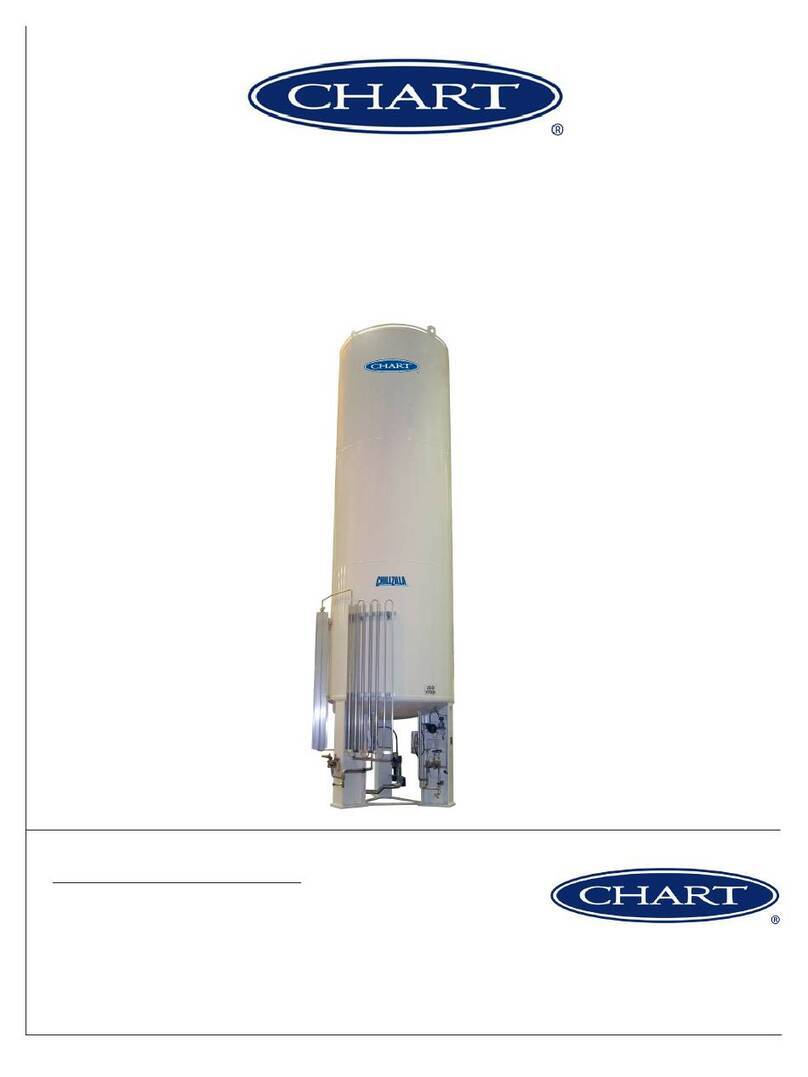
CHART
CHART ChillZilla VS-9000CZ User manual
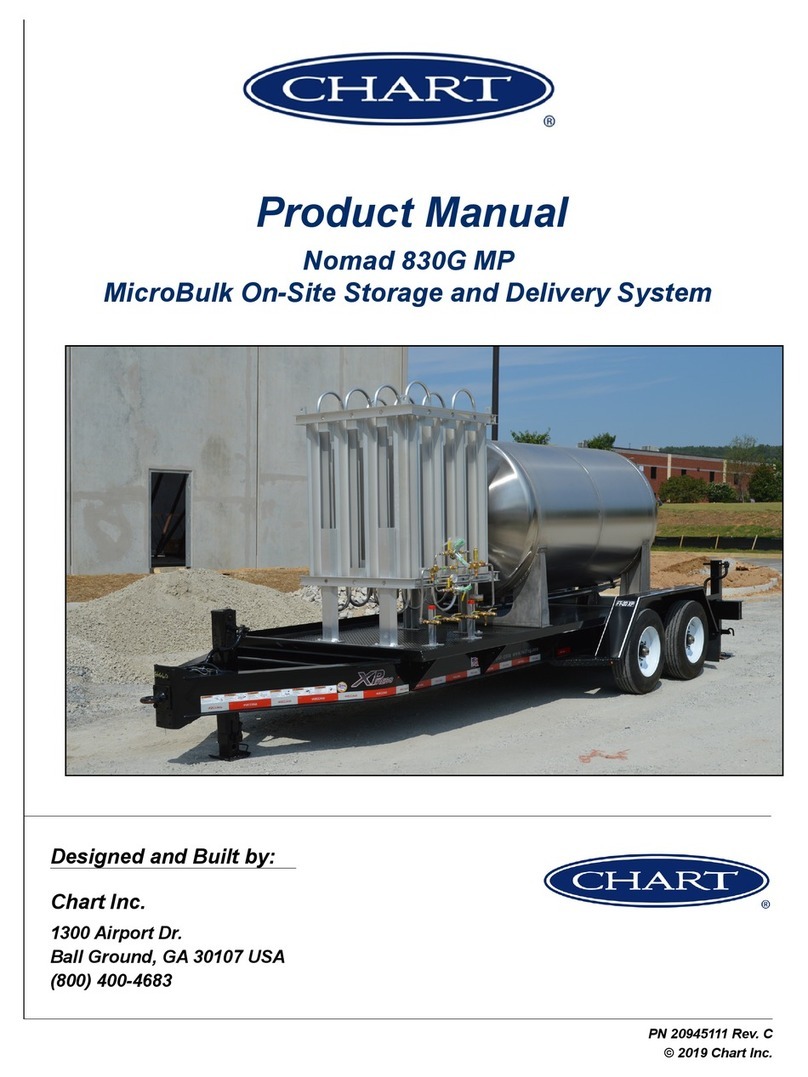
CHART
CHART Nomad 830G MP User manual
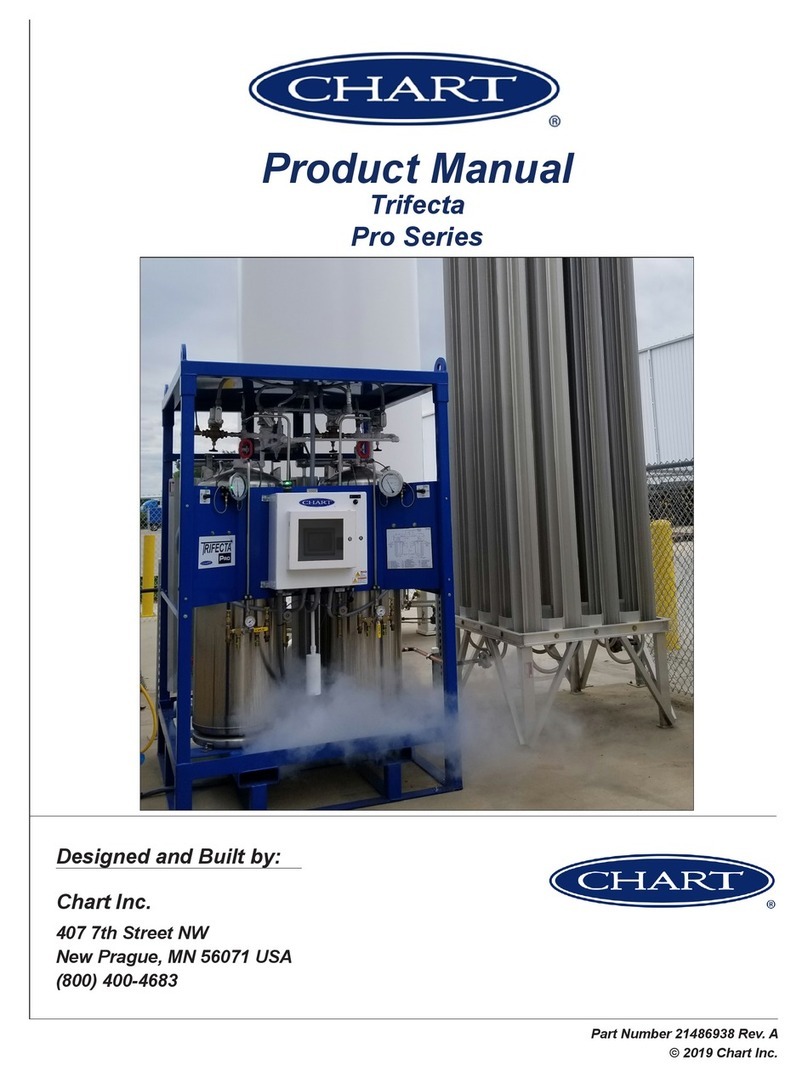
CHART
CHART Trifecta Pro Series User manual
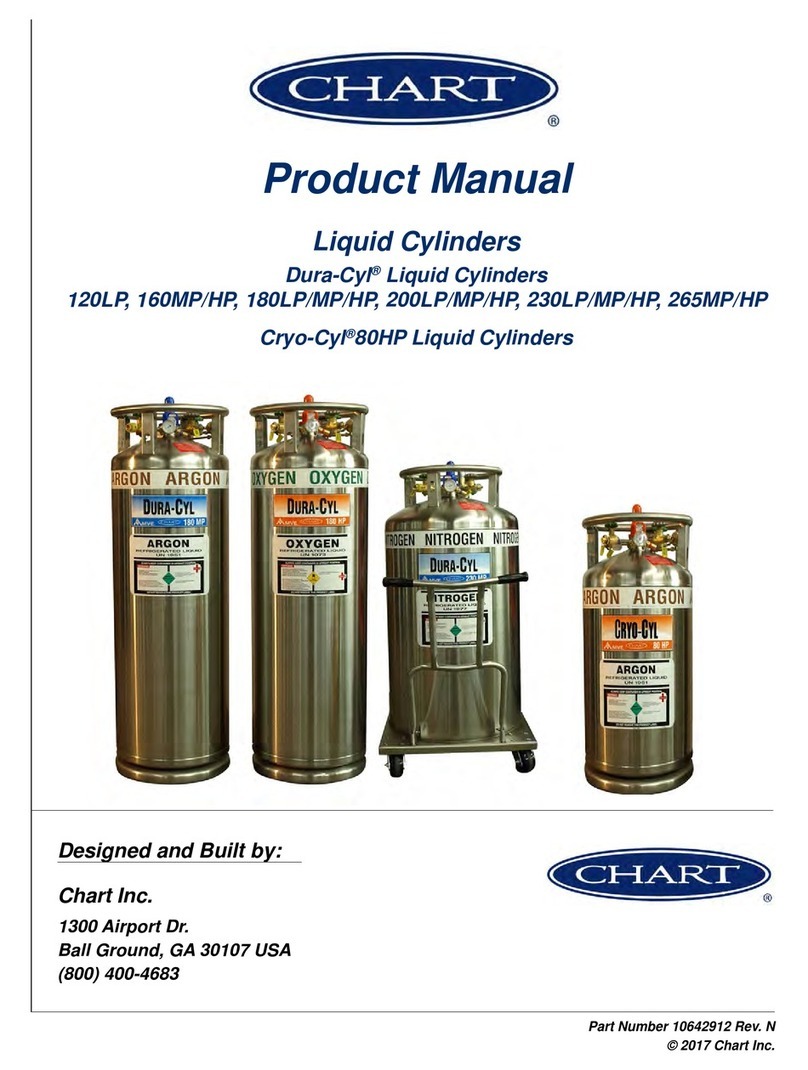
CHART
CHART Dura-Cyl 120LP User manual
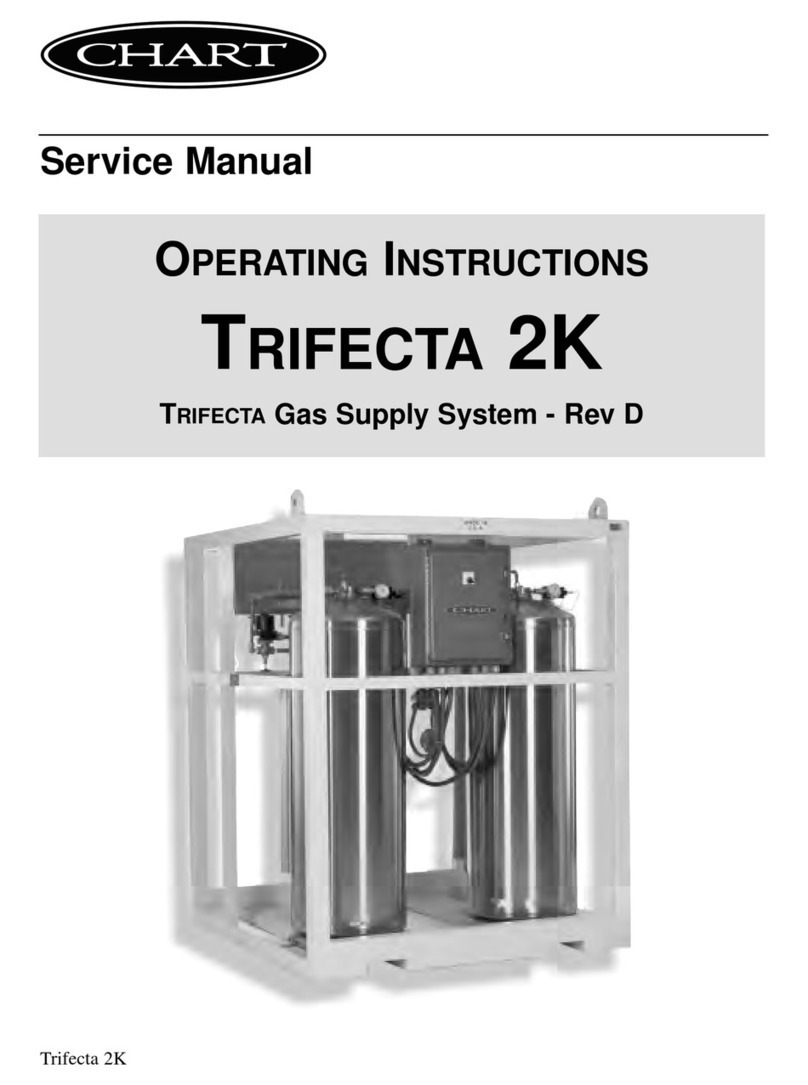
CHART
CHART TRIFECTA 2K User manual
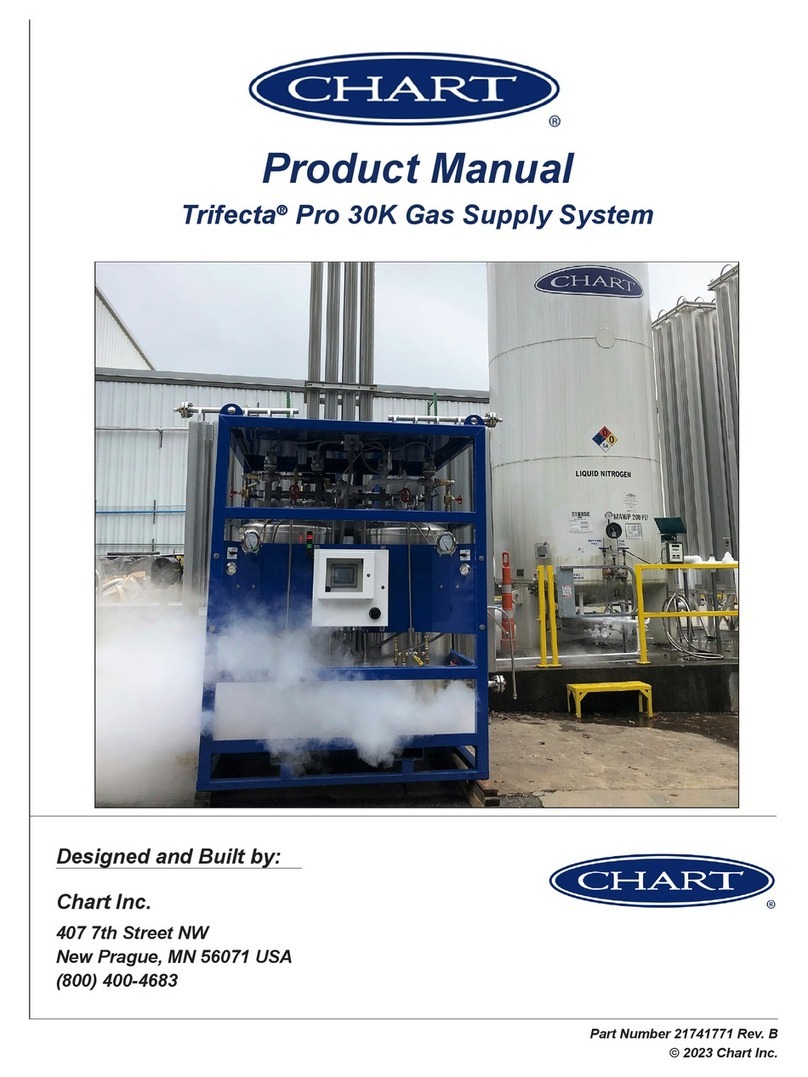
CHART
CHART Trifecta Pro 30K User manual

CHART
CHART ULTRADOSER 500S User manual
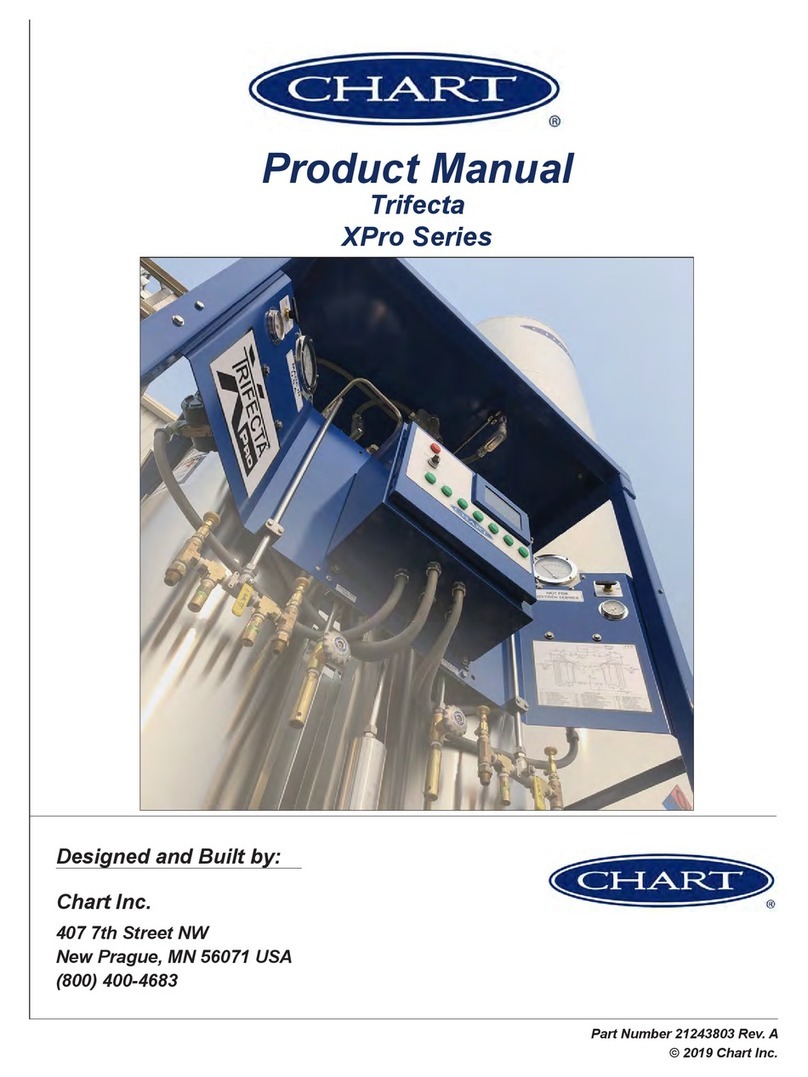
CHART
CHART Trifecta XPro Series User manual
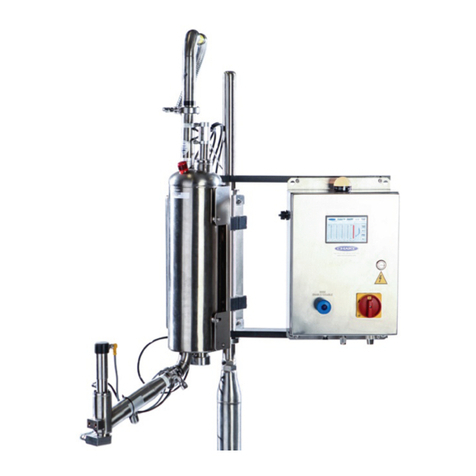
CHART
CHART CryoDoser FleX User manual

















